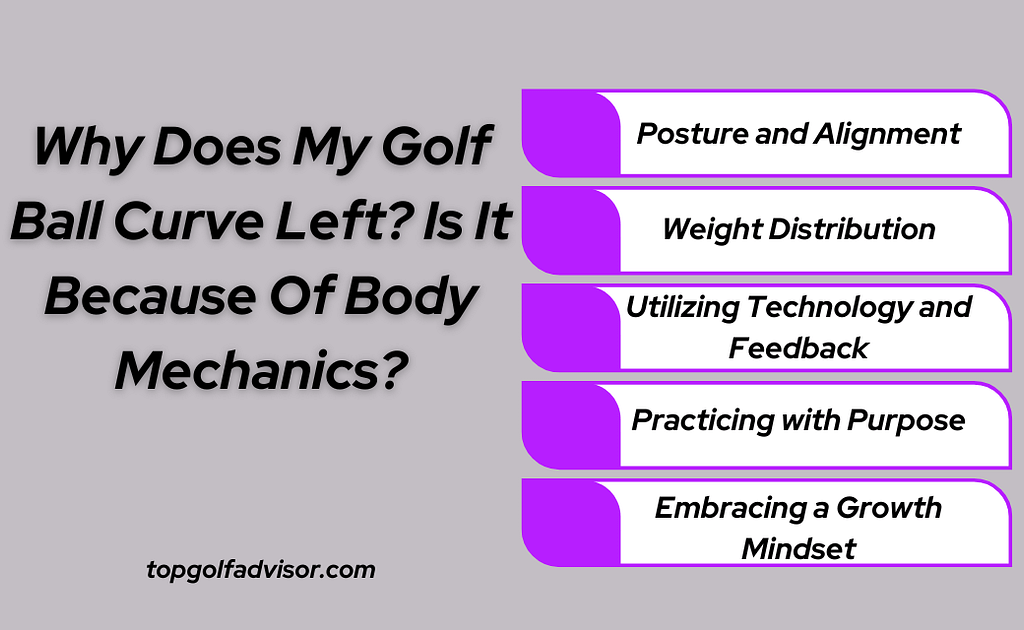You can hit a golf ball on the course in many ways. One of the most common shots is where you hit the ball straight, and it curves right (for right-handed golfers), but if it goes left, you’re left in a wondering state of why does my golf ball curve left. We might have the answer you’re looking for.
Golf is a game that defines precision and accuracy, however, it is also one of those games that can turn frustrating. Why is that? Because the pressure of getting the right shot always lingers in your head.
Nonetheless, as your trusted guide, we’re here to solve the mystery and provide you with an ideal solution that will improve your gameplay in the long run.

Why Does My Golf Ball Curve Left Learning the Physics Behind A Left Curving Golf Ball
Golf thrives based on physics; so many factors go into the perfect golf ball shot, such as clubface angle, swing rate, swing speed, and a few environmental issues.
When a golf ball curves left for a right-handed golfer, you can refer to it as a hook or a draw. Therefore, if you’re looking for a way to fix the issue, getting under the root cause of physics is essential.
Clubface Angle:
The key influencer for a left-curving golf ball is the clubface angle at impact. The ball will tend to curve left if the clubface is closed concerning the target line, i.e., pointing slightly left of the intended target. The ball is effectively given sidespin by this closed clubface, which causes it to veer off course.
The Swing Path Factor:
The course of your shots is mostly determined by the route of your swing and the clubface angle. For right-handed golfers, a swing path that moves from inside to outside the target line can also cause the ball to curve left. A closed clubface and this swing path intensify the sidespin effect, producing a noticeable hook or draw.
The Spin Role:
Another important component that affects how your golf ball travels is spin. A closed clubface with an inside-out swing path produces a clockwise spin on the ball (for right-handed players). This spin, called topspin, intensifies the ball’s leftward curvature, emphasizing the hook or draw effect even more.
Environmental Factors:
Although the main causes of a leftward-curving golf ball are clubface angle, swing path, and spin, environmental factors can also be involved. The texture and incline of the ground, along with the direction and severity of the wind, can all affect how your shots fly. Your strokes may curve further to the left when there is a right-to-left crosswind, and the ball may suddenly swerve off course if the lie is uneven.
How Do We Address the Issue:
Now that we know a few important elements causing the leftward curve in your golf ball, let’s look at some possible fixes to improve your game and straighten out your strokes.
Adjusting Clubface Angle:
A strategy to counter a golf ball curving leftward is changing the clubface angle when it hits the ball. Try opening the clubface slightly to counterbalance the clubface’s inclination to close throughout your swing. This modification can achieve straighter shots by reducing the amount of sidespin applied to the ball.
Correcting Swing Path:
Another tactic is changing your swing path to encourage a more neutral ball flight. Concentrate on swinging along the desired target line; avoid making too many inside-out swings that could result in a hook or draw. You can enhance your shot consistency and reset your muscle memory by engaging in activities that encourage a more neutral swing path.
Controlling Spin:
Decreasing the leftward curve of your golf ball requires control over spin. To maximize launch conditions and reduce spin, modify your ball position and angle of attack. To further lessen the impact of sidespin on your shots, think about utilizing gear with lower spin features, such as specific golf balls or club configurations.
Awareness About Your Surroundings:
Finally, remember that environmental elements could affect how your golf ball flies. To account for crosswinds, pay great attention to the direction of the wind and modify your aim accordingly. Observe the ball’s lay and try to predict how it might impact the trajectory and curve of your shots. Gaining a sharp understanding of these outside factors will enable you to modify your approach and make better decisions while on the course.
Why Does My Golf Ball Curve Left? Is It Because Of Body Mechanics?
In addition to clubface angle, swing path, and spin, the mechanics of your body during the swing also play a crucial role in determining the flight of your golf ball. Poor posture, improper weight distribution, and faulty rotation can all contribute to a leftward-curving shot.
- Posture and Alignment:
Maintaining good alignment and posture throughout your swing to ensure a steady ball flight. To encourage a square clubface at contact, ensure your feet, hips, and shoulders are parallel to the goal line. Steer clear of slanting too much forward or backward since this might cause off-center hits by interfering with your swing’s natural course.
- Weight Distribution:
To transfer power through the ball and achieve a consistent strike, you must distribute your weight properly from your back foot to the front during the downswing. Excessive forward motion or swaying can lead to inconsistent strikes and a lack of control over the motion of your shots.
Rotational Dynamics:
- Utilizing Technology and Feedback:
Technology can be a great ally if you’re trying to get better at golf and stop hitting shots that curve to the left. Use video analysis software or consult a certified coach to evaluate your swing mechanics and pinpoint areas that require work. You may identify areas where your technique needs improvement and make corrections to obtain a more constant ball flight with real-time feedback.
- Practicing with Purpose:
You must practice consistently to improve your golf swing and build the muscle memory required to produce a repeatable action. Include drills and workouts in your practice regimen that directly address the issues causing your shots to curve leftward. Careful practice may pay off on the course, whether it’s keeping a square clubface at impact or learning how to rotate your body properly.
- Embracing a Growth Mindset:
Lastly, have a growth mentality when taking on the task of correcting a leftward curve in your golf swings. See failures as chances for development and learning rather than insurmountable challenges. Remain patient and unwavering in your quest for development, understanding that obstacles to realizing your greatest potential as a golfer can be surmounted with commitment and work.

Conclusion:
In conclusion, these are the reasons you might be questioning why does my golf ball curve left. Leftward-curving golf balls might be an annoying challenge for golfers trying to improve their accuracy and consistency.
By thoroughly comprehending the fundamental principles of physics and adjusting crucial elements, including clubface angle, swing path, spin, and surrounding circumstances, you can proactively correct your strokes and enhance your performance on the course. Some people also ask that do speed of balls effect its curve? Check out our article on What Is A Fast Ball Speed In Golf
FAQs
How do I stop my golf ball from curving?
- Practice the proper weight transfer. I frequently see that almost all slicers have an inaccurate or ineffective weight transfer.
- Transform via collision.
- Aim not for a slice.
- Try a firmer grip to make it simpler to square up the clubface.
- Make use of milder flex shafts.
Why am I pulling my drives to the left?
Incorrect alignment, an overly firm grip, a ball location too far forward, or incorrect wrist angles during the golf swing can all contribute to the pull. A pull slice or pull hook can also be a part of a pull shot.
How do you hit a golf ball farther and straighter?
Ensure the club’s bottom points are straight ahead as you hold it behind the ball to avoid hitting it at an angle. To help reduce the loft of the club and help your ball go straight, hold the shaft of the club gently toward your front shoulder.
